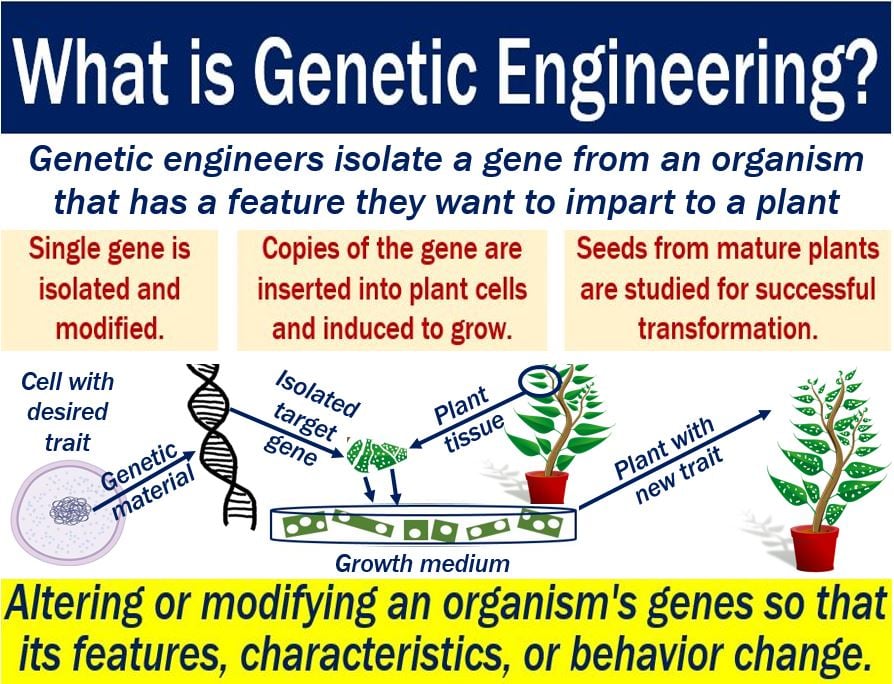Genetic engineering is about scientists altering the genes which exist in all living things. In other words, altering the ‘recipes’ for making life. We also call it GM. GM stands for Genetic Modifications. It is the process of manipulating or altering a living organism’s DNA. Scientists alter living things’ DNA to make them have certain characteristics.
DNA stands for deoxyribonucleic acid. It is a chemical inside the nucleus of a cell that carries a genetic code.
Our DNA determines what we look like, and to a certain extent, how we behave. In fact, DNA determines the color of our eyes, skin and hair, our height, and other features.
DNA consists of tiny units that carry information called genes.
We call genetic engineering scientists geneticists or genetic engineers.
Scientists who alter the genes of the animals and foods we eat work in the field of food biotechnology.

This image is an example of genetic engineering, the scientists isolated a gene from one organism that had a trait. They inserted the gene into the cells of a target plant and induced them to grow. The target plant acquired the trait from the other organism. The target plant’s genetically-modified seeds produced new plants with the trait of the other organism.
What may genetic engineering involve
Genetic engineering may mean changing one base pair, i.e., A-T or C-G, or deleting a whole DNA region. It may mean introducing an extra copy of a gene.
Sometimes, genetic engineers also extract DNA from the genome of another organism. They then combine it with the DNA of their target organism.
Why use genetic engineering?
Scientists use genetic engineering to modify or enhance the features and characteristics of an organism.
We can apply this technology to any type of organism. We can apply it to viruses, sheep, humans, and even plants.
With plants, for example, the technology can make them more resistant to herbicides or more nutritious.
How does genetic engineering work?
Let’s look at the pancreas of the human body, for example. It produces insulin, which helps regulate blood sugar levels. In fact, without insulin, sugar cannot enter our blood cells.
The pancreas of people with diabetes type 1 does not produce insulin. It does not produce insulin because their immune systems destroyed the pancreas’ beta cells. Beta cells produce insulin.
To control their blood sugar levels, people with diabetes must inject insulin.
Thanks to genetic engineering, scientists managed to produce a type of insulin that is very similar to human insulin. The insulin comes from bacteria and yeast.
In 1982, this modified insulin – Humulin – came onto the market. In other words, people with diabetes started using Humulin in 1982.
Genetic engineering in animals
Did you know that some cat breeders today sell cats that do not trigger allergies in susceptible humans? The cats are this way thanks to genetic engineering.
A feline expert from Bristol University says that we could remove a cat’s hunting instinct.
Scientists sometimes genetically modify animals for a specific purpose. They can, for example, genetically engineer environmentally-friendly pigs.
The pigs digest their food better so that their manure is less harmful to the environment.
Engineers today can clone animals. Cloning means creating a copy of a living thing, i.e., an identical copy.
In 1996, Dolly the Sheep was born. Scientists had cloned her from an adult cell.
Even before 1996, geneticists had cloned animals from embryo cells, including mice, frogs, and cows.
Most humans today who are not vegan or vegetarian have probably consumed genetically-modified animals or fish.
The FDA, America’s regulatory agency, regulates and monitors the genetic modification and changing of animals and fish. FDA stands for Food and Drug Administration.
The FDA carefully monitors because some studies have shown a link between GM foods and diseases. GM also stands for Genetically Modified.
Geneticists say that we will soon be able to eradicate some diseases that humans inherit from their parents thanks to genetic engineering.
Genetically engineering plants
University of Washington scientists genetically engineered trees so they could clean dirty water. The trees absorb the dirty water and then clean it before releasing it into the atmosphere.
Scientists have used genetic engineering to create trees for the timber industry. For example, there are some trees today that can grow super fast. Others grow very fast and also contain stronger and better quality wood.
Therefore, the timber industry does not have to chop down so many virgin forests. Additionally, it has more top-quality wood.
Scientists have genetically modified many of the plants we eat. We call them GM foods. For example, geneticists created an apple with a grape taste.
